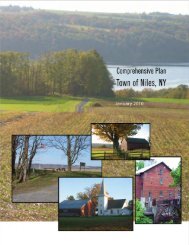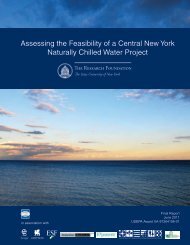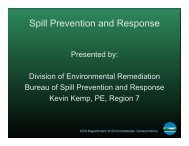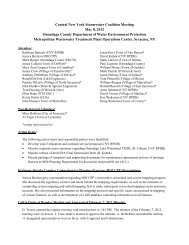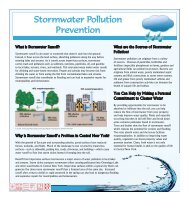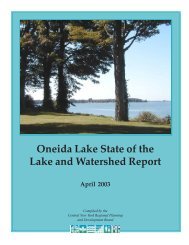A Management Strategy for Oneida Lake and its ... - CNY RPDB Home
A Management Strategy for Oneida Lake and its ... - CNY RPDB Home
A Management Strategy for Oneida Lake and its ... - CNY RPDB Home
Create successful ePaper yourself
Turn your PDF publications into a flip-book with our unique Google optimized e-Paper software.
Foreword<br />
As Chairman of the <strong>Oneida</strong> <strong>Lake</strong> Watershed Advisory Council Board of Directors, I am pleased to<br />
present A <strong>Management</strong> <strong>Strategy</strong> <strong>for</strong> <strong>Oneida</strong> <strong>Lake</strong> <strong>and</strong> <strong>its</strong> Watershed. This report culminates almost<br />
four years of research, planning <strong>and</strong> coordination by the Central New York Regional Planning <strong>and</strong><br />
Development Board, the Watershed Advisory Council Board of Directors, <strong>and</strong> many additional<br />
watershed leaders. During this time, I have attended nearly 40 meetings addressing the complex<br />
political, economic, <strong>and</strong> environmental issues involved in lake <strong>and</strong> watershed management planning.<br />
The volunteers <strong>and</strong> professionals that have worked alongside me throughout this process have<br />
contributed countless hours of their time <strong>and</strong> a wealth of knowledge <strong>and</strong> experience to help preserve<br />
<strong>and</strong> protect our watershed. We hope additional volunteers will become involved. In doing so they<br />
will become stewards of a self-sustaining process in which the lake community takes an active role in<br />
setting goals <strong>and</strong> making decisions.<br />
During the month of August, the watershed became a storm attractant. It seemed that every week we<br />
received one to two inches of rain. However, the last weekend of the month was the storm that added<br />
the proverbial “one drop too many.” Our creeks <strong>and</strong> storm systems were overwhelmed. The treatment<br />
plant that I manage was inundated <strong>and</strong> processed a one-day record amount of water. As I spent<br />
hour after hour with my staff keeping track of the collection system <strong>and</strong> treatment plant, I sought<br />
refuge in thoughts of what it would be like without these systems <strong>and</strong> the cooperative planning<br />
process they represent. The treatment plant is a perfect example of why watershed planning is<br />
important. There is power in cooperative stewardship. Rene Dubos, a Pasteur Institute Microbiologist<br />
<strong>and</strong> essayist, authored a book entitled the Wooing of Earth. His premise regarding the complex<br />
issues of environmental sustainability under pressures from human inhabitants is summed up within<br />
the concept of stewardship. Wooing the Earth, the romantic phrasing of the book, expresses this<br />
dynamic. In participating as a steward one becomes part of the communities’ self-determination.<br />
One must romance sustainability from the Earth. In order <strong>for</strong> us to do this we must place value in our<br />
surroundings. We do this through our choices with respect to our water <strong>and</strong> l<strong>and</strong> based resources.<br />
This analysis is always done with a backdrop of both political <strong>and</strong> economic <strong>for</strong>ces.<br />
Watershed planning is the fundamental way in which to organize these dynamics. A watershed is a<br />
unit we can see <strong>and</strong> underst<strong>and</strong>. For most of us it represents the obvious - streams, lakes, fish, <strong>for</strong>ests<br />
<strong>and</strong> fields. For some of us it represents change - a camp to a year round house, a farm field to a new<br />
housing community, the slow subsidence of a stream bank into the creek. Many of these changes<br />
become rallying cries <strong>for</strong> people to stop <strong>and</strong> think about their actions <strong>and</strong> impacts on the watershed.<br />
A watershed plan allows <strong>for</strong> change to take place <strong>and</strong> provides in<strong>for</strong>mation <strong>and</strong> knowledge to prepare<br />
<strong>for</strong> the impacts of those changes. The plan can also help us measure those impacts <strong>and</strong> guide us to<br />
better manage water resources in the future. I believe A <strong>Management</strong> <strong>Strategy</strong> <strong>for</strong> <strong>Oneida</strong> <strong>Lake</strong> <strong>and</strong><br />
<strong>its</strong> Watershed represents an important step in creating the path to a sustainable <strong>Oneida</strong> <strong>Lake</strong> community.<br />
Our water <strong>and</strong> l<strong>and</strong> resources are some of our most important assets. I hope this report <strong>and</strong> the<br />
others available on the website “woo” your romance <strong>for</strong> this watershed <strong>and</strong> the people that live here.<br />
Thank you.<br />
Dan Ramer, City of <strong>Oneida</strong> Sanitary Engineer<br />
Chairman, <strong>Oneida</strong> <strong>Lake</strong> <strong>and</strong> Watershed Advisory Council<br />
vii



